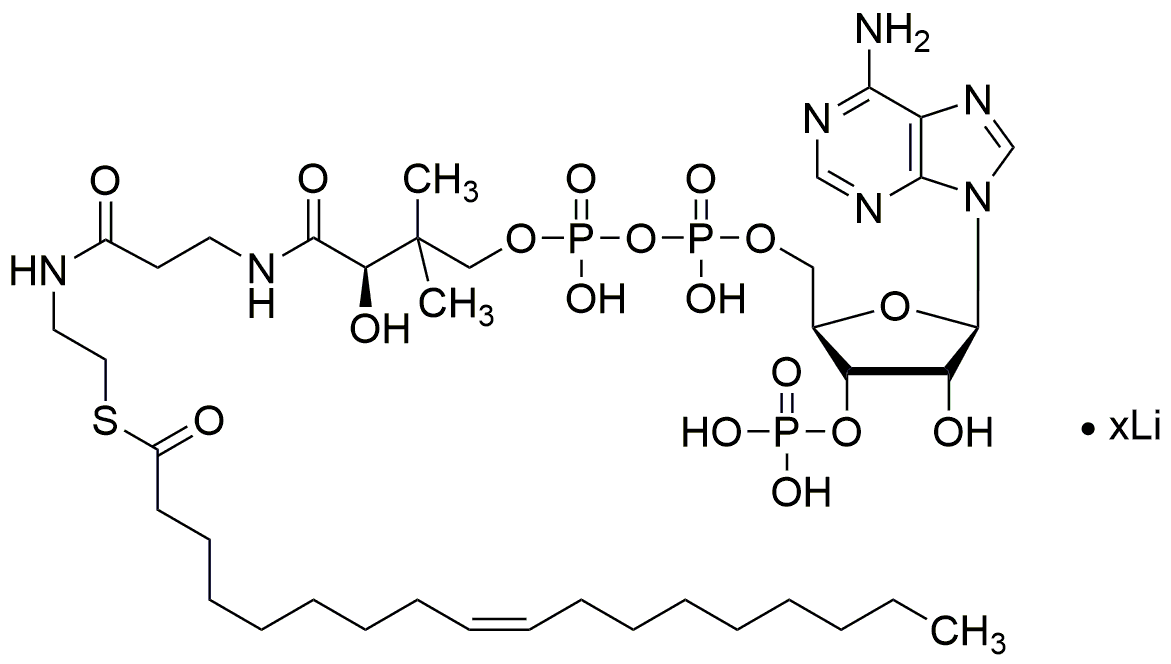Oleoyl coenzyme A lithium salt is widely utilized in research focused on:
- Biochemical Research: This compound plays a crucial role in metabolic studies, particularly in understanding lipid metabolism and energy production in cells.
- Drug Development: It is used in the formulation of pharmaceuticals aimed at treating metabolic disorders, offering a pathway to develop more effective therapies.
- Cell Culture Applications: Researchers employ this compound to enhance the growth and differentiation of specific cell types, aiding in tissue engineering and regenerative medicine.
- Enzyme Activity Studies: It serves as a substrate in assays to investigate the activity of various enzymes, providing insights into their mechanisms and potential inhibitors.
- Cosmetic Formulations: The compound is explored in the development of skincare products, leveraging its properties to improve skin hydration and barrier function.
General Information
Properties
Safety and Regulations
Applications
Oleoyl coenzyme A lithium salt is widely utilized in research focused on:
- Biochemical Research: This compound plays a crucial role in metabolic studies, particularly in understanding lipid metabolism and energy production in cells.
- Drug Development: It is used in the formulation of pharmaceuticals aimed at treating metabolic disorders, offering a pathway to develop more effective therapies.
- Cell Culture Applications: Researchers employ this compound to enhance the growth and differentiation of specific cell types, aiding in tissue engineering and regenerative medicine.
- Enzyme Activity Studies: It serves as a substrate in assays to investigate the activity of various enzymes, providing insights into their mechanisms and potential inhibitors.
- Cosmetic Formulations: The compound is explored in the development of skincare products, leveraging its properties to improve skin hydration and barrier function.
Documents
Safety Data Sheets (SDS)
The SDS provides comprehensive safety information on handling, storage, and disposal of the product.
Product Specification (PS)
The PS provides a comprehensive breakdown of the product’s properties, including chemical composition, physical state, purity, and storage requirements. It also details acceptable quality ranges and the product's intended applications.
Certificates of Analysis (COA)
Search for Certificates of Analysis (COA) by entering the products Lot Number. Lot and Batch Numbers can be found on a product’s label following the words ‘Lot’ or ‘Batch’.
*Catalog Number
*Lot Number
Certificates Of Origin (COO)
This COO confirms the country where the product was manufactured, and also details the materials and components used in it and whether it is derived from natural, synthetic, or other specific sources. This certificate may be required for customs, trade, and regulatory compliance.
*Catalog Number
*Lot Number
Safety Data Sheets (SDS)
The SDS provides comprehensive safety information on handling, storage, and disposal of the product.
DownloadProduct Specification (PS)
The PS provides a comprehensive breakdown of the product’s properties, including chemical composition, physical state, purity, and storage requirements. It also details acceptable quality ranges and the product's intended applications.
DownloadCertificates of Analysis (COA)
Search for Certificates of Analysis (COA) by entering the products Lot Number. Lot and Batch Numbers can be found on a product’s label following the words ‘Lot’ or ‘Batch’.
*Catalog Number
*Lot Number
Certificates Of Origin (COO)
This COO confirms the country where the product was manufactured, and also details the materials and components used in it and whether it is derived from natural, synthetic, or other specific sources. This certificate may be required for customs, trade, and regulatory compliance.


